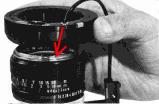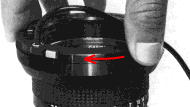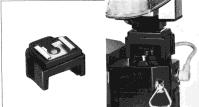How to Use the CAT System
Attachment of the Flash Auto Rings A2 and B2 |
|
3. All other operations are the same as for the original Flash Auto Rings A and B. |
 |
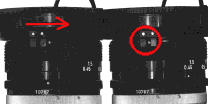 |
Canon Speedlite 133D |
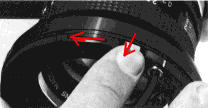 |
|
|
Synchronizing an Ordinary
Flash Unit
The ordinary flash unit can be connected to tt accessory shoe by means of the Flash
Coupler with a hot shoe.
When using the flash unit without flash shoe the cord should be connected to the
terminal locate on the side of the camera body.
With an electronic flash, shutter speed must b, 1/60 sec. or slower. When using the
flash bulbs shutter speed will vary according to the type o flash bulb used. With
FP class any speed can be chosen except 1/60 and 1/,30 of a second, and with the
M and MF, a shutter speed of 1/15 sec. or lower must be used.
Exposure
can be decided by the following formula:
Guide number Divided by focusing distance = f/stop. Consequently, the f/stop can
be obtained after focusing the subject.
In this calculation, be sure not to confuse meters with feet.
Even when using the 133D, if a iens without a coupling pin, this is necessary to
obtain the f/stop. The guide numbers shown are applicable only after the neon lamp
turns on. For your reference, a comparative table of apertures is attached. The switch
should be set at the MANUAL position. With the CAT System, flash photography
can be performed when the charged voltage is at a low level. However, when the switch
is set at MANUAL, neon lamp turns on at a higher voltage than the minimum required
for the CAT System: For this reason, separate switches are provided for automatic
and manual operation.
Technical Data
Type: Direct-coupled, cl m-on type CAT System
Guide number: 18 meters (60 feet) at ASA 10C
For both monochrome and color.
Color temperature: 6000° K, Correc tion witt
green filter.
Flash beam angle: 55° vertical and horizontal.
Flashing intervals: When using new batteries:
Manganese battery: Approx. 7 seconds
Alkaline battery: Approx. 5 seconds
Flashing time: 1/1000sec.
Number of flashing:
Manganese battery: Approx. 80 times
Alkaline battery: Approx. 300 times
Power source: 4 penlight batteries.
Pilot lamp: Built in.
Contacts: Direct-coupled type syschronizing contact,
automatic flash control contact, socket for connecting to Flash-Auto Ring.
Size: 90 x 74 x 35mm. (3-9/16" x 2-15/16"
x 1-3/8").
Weight: 17Og. (60z.).
| Back to CAT Index Page |
Concept | Reliability Issue | Motor Drive Units | Macro
| EE
Servo /
Booster Finder | Bulk Film Back | CAT
(Flash System | F1 High
Speed |
ODF-1 | Placid
| Assembling
Diaphragm |
Canon FD & FDn lenses
| Back | to Main Index Page of Canon F-1(n)
| Message Board |
for your Canon F-1(n)
SLR camera(s)
| Message Board | for your Canon optics
in a shared environment
| Message Board | Specifically tor Dispose or Looking for Canon Photographic
equipment
Other Canon
Resources: If
you
have a New Canon F-1...
Canon
FD Lenses Site | Canon A and T Series SLR models
About this photographic site.
Home - Photography
in Malaysia
Copyright
© 1999. leofoo ®. MIR Web Development Team.
MB
Maintenance Team
and Credit
information:
Kaipin & Terry Carraway. Mr. Richard Yeow, General Manager
-Optical Division of Canon
Marketing
and Tony Kano, former regioner head of Canon, Asean Region for granting special
permission to reproduce some of the old manuals into HTML format. *
Canon, T90, FD Lenses,
Canon
Marketing
are registered trade names or trademarks of Canon Inc. Japan.
